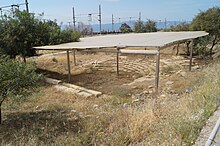Krommyon
Krommyon ( Greek Κρομμυων ) was a place in ancient Greece east of the Isthmos of Corinth on the Saronic Gulf . The city is said to be named after the mythical hero Krommyon, son of Poseidon . The name, which is derived from the Greek word for onion, indicates that onions were already grown here in ancient times. According to legend, Theseus killed the Krommyonian sow Phaia here .
The ancient Krommyon is believed to be in the present day Agioi Theodoroi . Ancient foundations were found here on both sides of the Autobahn 8 . The finds range from the Geometric to Byzantine times . Originally Krommyon was part of Megara . In the 6th century BC It was conquered by Corinth . 425 BC During the Peloponnesian War , the city was devastated by Nikias . 393 BC During the Corinthian War , the Spartan military leader Praxitas conquered the city and used it as a military base. During the Roman and Byzantine times, the place was moved closer to the port of Krommyon. In the 6th century the place is still listed by Hierocles in his city list.
The excavation site, which is around 110 m long and 30 m wide, is now located between Autobahn 8 and the new railway line, around 100 m west of the Agioi Theodoroi train station. A cemetery from the Geometric period, a late Archaic theater and a pottery workshop from the 4th to 2nd centuries BC were found here. The circular theater has a diameter of about 13 m and 11 rows of seats. The interior was paved with stones and had a diameter of about 7.40 m. It is believed that the theater served as a popular meeting place ( bouleuterion ).
literature
- Conrad Bursian : Geography of Greece. Volume I. Northern Greece. 1862-1872. Reprinted in 2002, ISBN 0543970671 .
- Ernst Meyer : Krommyon. In: The Little Pauly (KlP). Volume 3, Stuttgart 1969, column 355.
- Siegfried Lauffer (Ed.) Krommyon In: Greece. Lexicon of Historic Places. , Augsburg 1999.
Web links
Individual evidence
Coordinates: 37 ° 55 ′ 55 ″ N , 23 ° 8 ′ 3 ″ E
